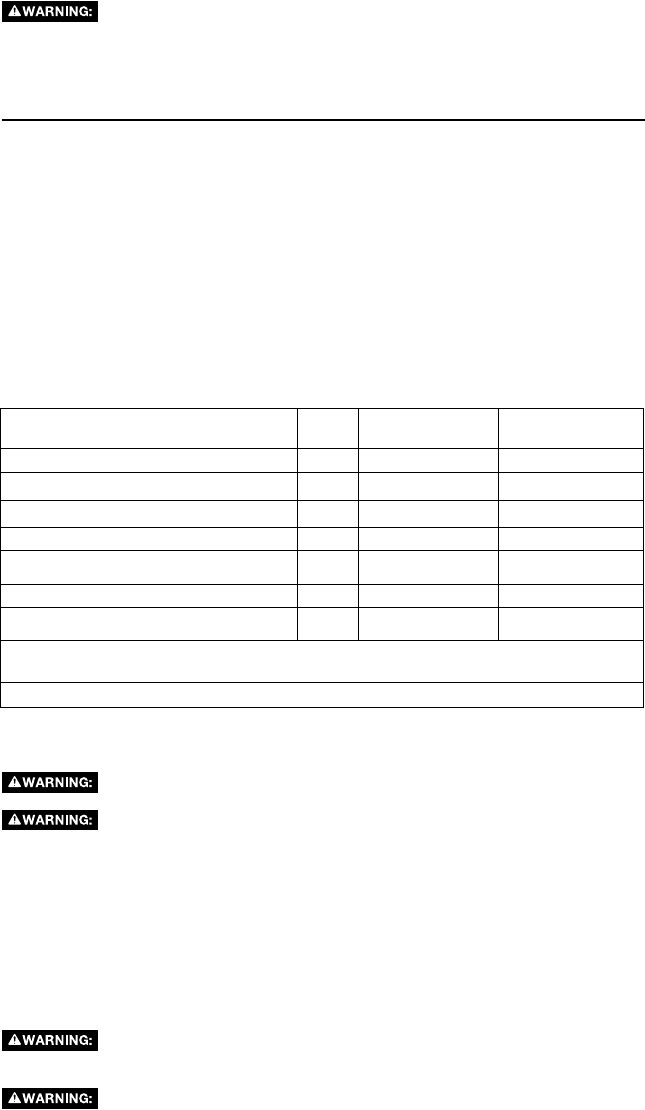
12 13
Risk of bursting. Drain air tank daily. Water will condense in air tank. If not
drained, water will corrode and weaken the air tank causing a risk of air tank rupture.
5. Allow the compressor to cool down.
6. Wipe air compressor clean and store in a safe, non-freezing area.
MAINTENANCE
The following procedures must be followed when maintenance or service is performed on the
air compressor.
1. EnsureOn/Off switch is in the OFF position.
2. Remove air compressor plug from outlet.
3. Drain air tank.
4. Allow air compressor to cool down before starting service.
NOTE: All compressed air systems contain maintenance parts (e.g., oil, filters, separators) that
are periodically replaced. These used parts may contain substances that are regulated and
must be disposed of in accordance with local, state, and federal laws and regulations.
NOTE: Take note of the positions and locations of parts during disassembly to make reassembly easier.
NOTE: Any service operations not included in this section should be performed by a BOSTITCH
factory service center or a BOSTITCH authorized service center.
MAINTENANCE CHART
Procedure Daily Weekly
See tank
warning label
Check Safety Valve (G) X
Inspect air filter X
Drain air tank X
Checkforunusualnoise/vibration X
Check for air leaks X
1
Clean compressor exterior X
Remove tank from service
X
2
1 - To check for air leaks apply a solution of soapy water around joints. While compressor is pumping
to pressure and after pressure cuts out, look for air bubbles to form.
2 - For more information, cal
l1-800-556-6696
CHECKING SAFETY VALVE
Risk of bursting. If the Safety Valve (G) does not work properly,
over-pressurization may occur, causing air tank rupture or an explosion.
Risk from flying objects. Always wear certified safety equipment :
ANSIZ87.1eyeprotection(CAN/CSAZ94.3)withsideshieldswhenusingthecompressor.
Before starting compressor, pull the ring on the Safety Valve (G) to make sure that the Safety
Valve(G)operatesfreely.NOTE:Ringmaybedifficulttopullwhenairtankpressureisat0psi.
If the valve is stuck or does not operate smoothly, it must be replaced with
the same type of valve.
DRAINING AIR TANK (FIG. 1)
Note: The amount of water drained from the tank after each use will depend on the time of use
and the amount of humidity in the operating environment. If no water comes out of the drain
valve, the valve may be clogged. If the valve is clogged, release all air pressure from tank. The
valve can then be removed, cleaned and reinstalled.
Risk of unsafe operation. Risk from noise. Air tanks contain high
pressureair.Keepfaceandotherbodypartsawayfromoutletofdrain.Useeyeprotection
[ANSIZ87.1(CAN/CSAZ94.3)]whendrainingasdebriscanbekickedupintoface.
Riskfromnoise.Alwayswearproperhearingprotectionduringuse.Under


















